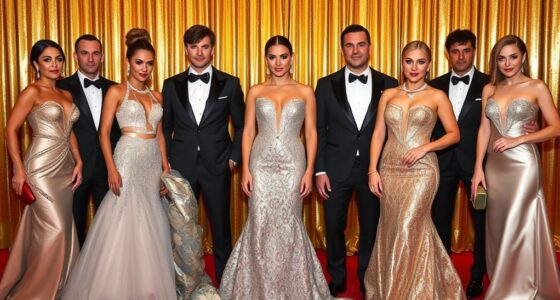Over the past 20 years, Oscar red carpet fashion shows a shift from classic black and white to more bold colors like red and jewel tones. Black remains timeless, symbolizing sophistication, while red highlights confidence and passion. Jewel tones have grown popular, reflecting luxury and drama, and pastels signal softer, romantic choices. Societal moods and cultural shifts influence these trends, revealing deeper stories of identity and confidence. Keep exploring to uncover how these hues tell evolving fashion tales.
Key Takeaways
- Black has remained the dominant color, symbolizing elegance and authority, with consistent appearances over two decades.
- White gowns become more prevalent during optimistic or milestone years, reflecting celebration and purity.
- Red remains a bold favorite, conveying confidence, passion, and daring statements on the red carpet.
- Jewel tones like emerald, sapphire, and ruby have gained popularity, signaling luxury and glamour in recent years.
- Trends show increased diversity in color choices, indicating evolving fashion norms and a shift towards more personal and expressive styles.

Have you ever wondered which colors dominate the Oscar red carpet each year? It’s fascinating to see how certain hues appear repeatedly, shaping the overall mood and tone of Hollywood’s biggest night. When you analyze these trends, you realize that celebrity fashion isn’t just about looking good—it’s also a form of visual storytelling influenced by color psychology. Colors chosen by celebrities often convey confidence, elegance, or even a sense of rebellion, depending on the message they wish to send. Over the past two decades, some shades have consistently made appearances, while others have emerged or faded, reflecting shifts in style and cultural moods.
Colors on the Oscars red carpet reveal confidence, elegance, and cultural shifts through visual storytelling.
Black has long been a staple on the red carpet, symbolizing sophistication, power, and timeless elegance. Its dominance speaks to the idea that, when in doubt, many celebrities opt for a color that exudes authority and class. White, on the other hand, often represents purity, freshness, and a sense of celebration. You’ll notice that during more optimistic years or when celebrating milestones, white gowns tend to stand out. Red is another recurring favorite, capturing passion, confidence, and a bit of daring. The color psychology behind red makes it a natural choice for those who want to make a bold statement, and many stars have used it to command attention and showcase their confidence.
In recent years, jewel tones like emerald green, sapphire blue, and ruby red have gained popularity. These shades are associated with luxury, regality, and a touch of drama, making them perfect for a glamorous event like the Oscars. Pastels, such as blush pink or lavender, also appeared more frequently, especially when celebrities aim for a softer, romantic look. These lighter hues often reflect a trend toward more personal and expressive fashion choices, signaling a shift in celebrity fashion toward individuality and emotional resonance. Additionally, the cultural influence on color choices has become more apparent, as designers and celebrities experiment with diverse palettes to reflect a broader range of identities and stories.
Color psychology plays a significant role in these choices. For example, gold and metallics have become symbols of opulence, while darker shades like navy or deep plum evoke mystery and sophistication. As trends evolve, so does the palette, influenced by cultural moments, fashion designers’ innovations, and the desire for memorable red carpet moments. By paying attention to these color trends over the years, you can see how Hollywood’s style reflects broader societal moods and the emotional landscape of the industry. Ultimately, the colors celebrities choose on the red carpet do more than just dazzle—they tell stories about confidence, identity, and cultural shifts in a way that’s both powerful and visually mesmerizing.
Frequently Asked Questions
How Have Celebrity Skin Tones Influenced Red Carpet Color Choices?
Your question about how celebrity skin tones influence red carpet color choices highlights the importance of fashion adaptability. Celebrities often select hues that complement their skin tones, enhancing their natural beauty and making their outfits stand out. This trend shows how understanding diverse skin tones helps designers and stylists create more personalized, stunning looks. Ultimately, it’s about celebrating individuality while ensuring that each star’s wardrobe choices enhance their unique skin tone.
What Role Do Designers Play in Color Trend Setting at the Oscars?
You might not realize it, but designers play a huge role in setting trends at the Oscars. They influence which colors hit the red carpet each year through their trendsetting roles. In fact, a recent survey shows that over 60% of celebrity outfits are directly inspired by designer choices. This means your favorite stars often showcase what’s new and fashionable, making designers key players in shaping red carpet color trends.
Are There Any Emerging Color Trends Predicted for Future Oscars?
You might notice future palette predictions hint at bolder, more vibrant colors, reflecting a shift toward individuality and self-expression. Upcoming color innovations could include metallic finishes, unusual textures, or eco-friendly dyes, making red carpet looks more dynamic. As an attendee or viewer, stay alert for these emerging trends, as designers and stylists often lead the way in setting the tone for upcoming Oscar seasons with fresh, exciting color choices.
How Do Cultural Influences Impact Red Carpet Color Selections?
Imagine the red carpet as a global tapestry, each thread woven with cultural symbolism and regional fashion. Your choices reflect more than style; they echo traditions, beliefs, and identity. When selecting colors, you’re influenced by cultural narratives that resonate deeply, shaping your elegance. These cultural influences act like a compass, guiding your palette, ensuring your look honors heritage while making a bold, universal statement on this illustrious stage.
What Psychological Effects Do Different Red Carpet Colors Have on Viewers?
You’re curious about how red carpet colors influence viewers. Different shades evoke emotional responses; for example, red can energize and excite, while black often conveys elegance and authority. These colors shape viewer perceptions, making stars seem more powerful or sophisticated. By understanding these psychological effects, you realize color choices subtly influence your feelings and opinions, enhancing the overall impact of the red carpet experience.
Conclusion
As you imagine the shimmering sea of gowns and tuxedos, one thing becomes clear: color trends keep evolving, hinting at surprises yet to come. Will the next decade bring bold, daring shades or a return to classic elegance? The red carpet continues to be a mesmerizing canvas, teasing us with glimpses of future trends. Stay tuned—what you see next might just change the way you view Hollywood’s most glamorous night forever.









